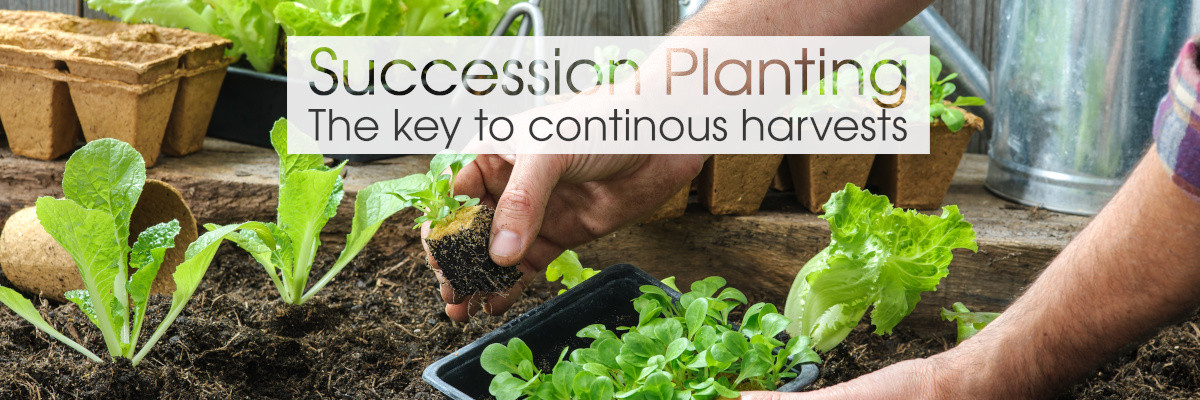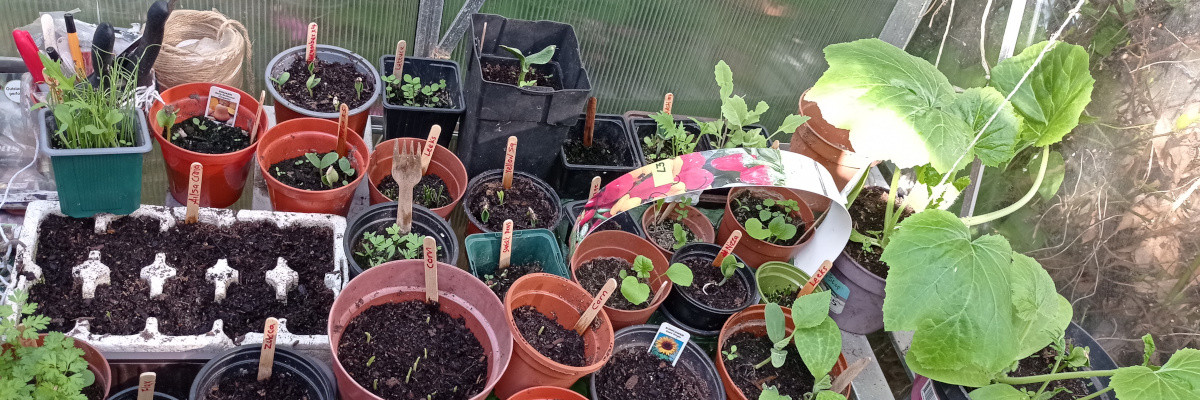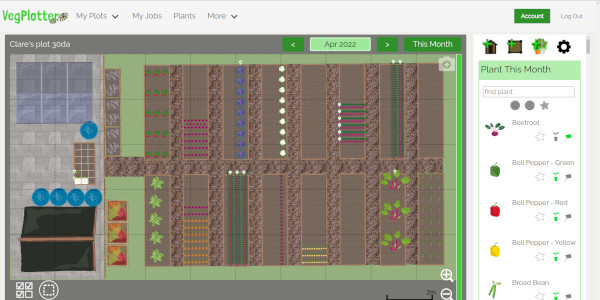Succession Planting For A Thriving Garden

If you are relatively new to gardening, you may have a windowsill full of plants now waiting to go into the soil outside after the last frost. If you can plant hardy seeds directly into soil outdoors, these seeds get a head start before all your baby seedlings go in. You may have heard of succession planting as a way to keep harvesting crops because you do not plant them all at the same time. Let’s examine what succession planting is and which seeds succession planting is useful for.
What is succession planting?
In your garden, you plant seeds at regular intervals so that they will not all ripen or mature at exactly the same time. You need to plan carefully which seeds follow each other so that your crop rotation (see our Crop Rotation Article) is in place. So, follow salads with peas or beans, followed by brassicas (the cabbage family), and then roots. Fast-growing carrots can be harvested in as little as 12 weeks and if you plant again every 3 weeks or so, then you can keep picking carrots for a long time. Make sure that one plant family follows another in the garden to avoid pests and diseases.
Which vegetables suit succession planting?
Crops that mature quickly can be planted a few weeks apart. Radishes, carrots, lettuce, and salad greens are all perfect. Peas and beans that grow in different temperatures are excellent because you plant hardy peas and beans in the autumn, pick them in late spring and then plant a new row of both in a different row early in spring to harvest a few months later.
Peas and beans have many varieties so you can choose hardy varieties (like Broad beans) for growing from the autumn onwards, and plant beans that prefer warm soil in late spring, just as you harvest the broad beans.
Radishes and carrots can be planted directly into the soil in March, sow another row in April, and another in May. Keep planting until July and they will have time to mature. This way you can harvest radishes after a few weeks and keep harvesting carrots from June through to the autumn. Remember companion planting? Try to grow some marigolds near carrots too, to keep carrot root flies at bay.
Sow little but frequently and you will always have something to pick. If going on holiday, soak the ground well, sow some seeds before you go, and ask a friend to water or hope for some rain! By the time you come back, you can have a row of leafy salads ready to pick.
Remember that some plants just keep flowering, fruiting, and producing like aubergines (Eggplants US), cucumbers, melons, summer squash, tomatoes and peppers. With all of these, you only plant them in soil when the cold winter has disappeared and they keep growing as long as the weather is warm enough so there is no need to succession plant any of these. You just need to keep watering and harvesting them so the plants will continue to produce fruit until the first frost arrives.
How often should I sow seeds?
This depends on how much you and your household eat. If it is carrots, think how many carrots your family eats in a week. I find planting a small row of carrots every 3 weeks is ideal for me. I would not plant as many radishes because although I love them, when they are ripe there are lots of other things to eat too so I plant a row of radishes to mark a plot, like between a row of cabbages. This way, the radishes sprout quickly, but the cabbages grow more slowly. Often the radishes are picked before the cabbages have reached 6 inches high.

What is a glut?
If you are new to gardening you may plant a whole packet of seeds, water them diligently and then notice that they are all ready to harvest at the same time. This is a “glut”. You eat as many as you can but eventually, somebody in the family says “No more carrots!” I even find this with huge crops of strawberries. They are delicious but during the summer you need a lot of time to plant, water, and pick everything so sometimes a bag of strawberries or raspberries is popped into my freezer. You can give some to neighbours, friends, and family but you will also find ways to store excess fruit and vegetables for the winter. Many experienced allotmenteers are always talking about making jam (preserves, jelly US) mid-summer or harvesting autumn tomatoes and cucumbers to make chutney or pickles. Succession planting will stagger these “gluts” and planting at regular intervals delays maturity, but still allows you to keep harvesting.
Do not forget your crop rotation plan!
Use your VegPlotter plan to remember what you planted where. Snap pictures of your first rows of fruit or vegetables and keep track of them as you decide which seeds to plant next. Salads can grow anywhere because they only grow for a short time and their roots are not long and deep like the slow-growing cabbage family. You can sow a row of lettuce between slower-growing potatoes, and this is often labelled a “catch crop”. This means you can use the soil for a fast grower, pick the harvest and then allow the main crop, the potatoes to continue to grow more slowly.
Imagine a typical growing season where you follow the early salad greens or radishes with peas or beans. Remember these fix nitrogen into the soil, which is really useful for a follow-on crop like slower-growing Brassicas. This could be Brussels sprouts, cabbages, broccoli, or kale. While you pick peas and beans, get ready for a crop of small cabbages to overwinter in that spot. Some gardeners have a “nursery bed” where they start the brassicas by sowing directly and then transplant them to their permanent site after the first harvest of peas or beans. If you have space anywhere, plant another row of salad greens to try to extend your harvest as long as possible.
Hints
Use different varieties to make the most of the season and the soil temperature. Seed packets tell you when you can plant and this can guide your succession sowing.
Hardy peas or beans like Broad beans can be sown in the autumn, to be picked in the spring. Plant a second row of Broad beans if, like me, you love them so much you eat the first lot and do not save the seeds! You can pick spring peas and broad beans and while these beans are being harvested, plant a new row of maincrop peas for summer, along with French, green, or haricot beans to grow for summer picking. Then when the cooler air of autumn arrives, you can plant the Broad bean seeds saved from the spring harvest and a new crop of peas. Remember not to keep planting peas and beans in the same spot every year; move them around in line with the crop rotation plan.
Make sure to follow the beans with some brassicas like cabbage or Sprouts.
Salads can fit in anywhere on your crop rotation plan because they do not have deep roots and they do not stay in the soil for long. Radishes are another quick-growing crop and quite hardy in the UK too.
Courgettes (Zucchini US) and Amaranth need long, hot summers with irrigation so it’s best to sow them indoors to get a head start and then do a second crop outdoors sowing directly into the ground. You may be lucky enough to get an Indian summer and find that your courgettes are still growing in late September.
Carrot root fly tends to affect early sowings more than later sowings, so make sure to cover these rows with fleece to keep them away. A good tip is to plant carrots high in a raised bed because the carrot root fly does not climb too high, generally not above 2 feet (60 cm) above soil level.
Conclusion
So try to implement some of the planting strategies discussed today to have regular supplies of fresh fruit and vegetables right through the year but no gluts. Use succession planting to try lots of different varieties of the same plant, or to intersperse beds of overwintering crops with rapidly growing radishes, lettuce, or salads. Send us pics of any success stories! Next week, let’s look at ways of planning your family vegetable garden so your children can enjoy being outdoors, and you can benefit from having lots of extra help watering, planting, and picking.



